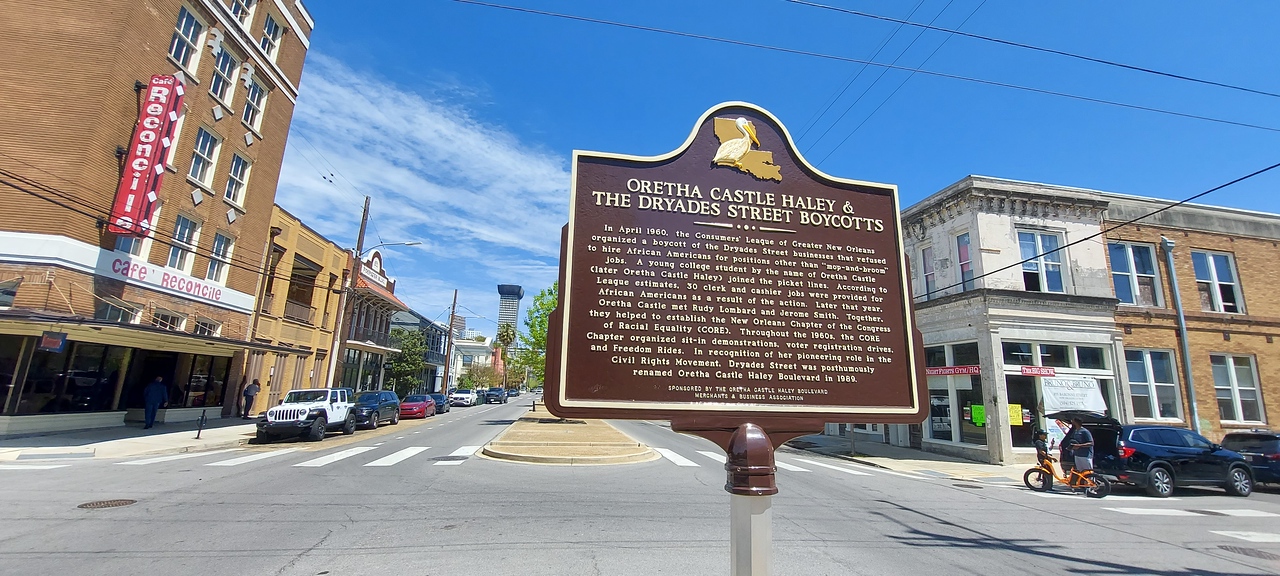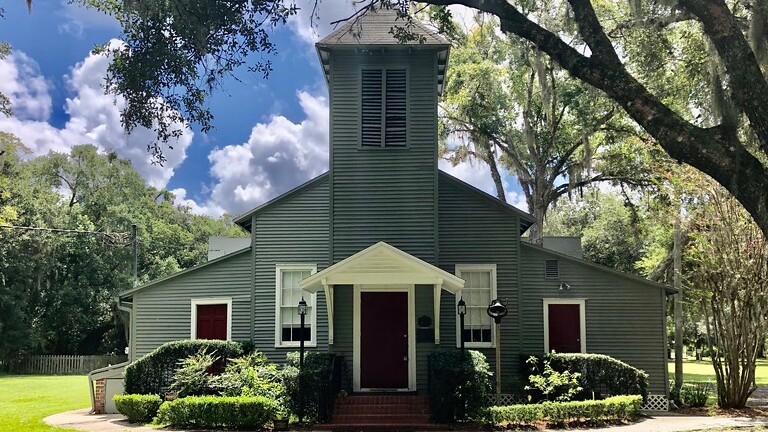
Ever wonder what a historic neighborhood commercial district in Jacksonville can resemble after revitalization in the form of “withintrification”? Oretha Castle Haley Boulevard in New Orleans is a good model that can be easily replicated locally along corridors like Myrtle Avenue, Kings Road, A. Philip Randolph Boulevard, Moncrief Road, Main Street, Edison Street, McDuff Avenue and more.
What is ‘Withintrification’?

A March 2024 view of Oretha Castle Haley Boulevard | Ennis Davis
Most cities across the country have historic neighborhood commercial districts that have declined since the 1970s. In many cities, there are also similar districts that have undergone significant gentrification. However, it’s difficult to find good examples of “withintrification” of neighborhood commercial revitalization.
In contrast to gentrification, “withintrification” refers to revitalization that’s driven by the people already in the neighborhood. It means identifying assets in the community, bringing them together under common objectives, and raising the value of the place from within at a pace appropriate for revitalizing the existing community, not displacing it. The residents of the community take the lead in revitalization, rather than newcomers or outside developers telling residents what they need and ultimately pricing them out. The term was coined by University of Pittsburgh Professor and Pastor John Wallace.
While common thought is that displacement is inevitable as revitalization occurs, Oretha Castle Haley Boulevard is an example that suggests otherwise. Oretha Castle Haley Boulevard is a historic commercial hub that has served the predominately African American neighborhood of Central City in New Orleans, Louisiana.
Oretha Castle Haley Boulevard History

Central City’s Dew Drop Inn was an important stop on the Chitlin’ Circuit and was noted as “the most important and influential club” in the development of rhythm and blues music in New Orleans. It recently reopened. | Ennis Davis
Separated from downtown by the Pontchartrain Expressway, Central City is a predominantly working-class African American neighborhood associated with the city’s brass band and Mardi Gras Indian traditions. Dryades Street was the neighborhood’s commercial epicenter as far back as the 1830s.
Dryades Street was designed by Creole architect Barthelemy Lafon in 1809. In 1849, Dryades Market was established by the City of New Orleans at the intersection of Dryades and Melpomene (now Martin Luther King, Jr. Boulevard) streets. For many years, the public market was one of the largest in the city. Anchoring Dryades Street, the market attracted additional commercial activity to the corridor.

A Masonic parade at the corner of Philip and Dryades Street | Historic New Orleans Collection
By the 1950s, with more than 200 businesses, Dryades Street had become the main commercial destination for New Orleans’ Black community. However, while the majority of the shoppers were Black, few were business owners or able to obtain employment at retail establishments along the corridor.
During the 1950s and ’60s, Dryades became the focal point of the city’s civil rights movement with local residents like Oretha Castle Haley (1939-1987) playing a leading role in the movement. In 1989, eight blocks of Dryades Street were renamed in honor of Haley, who challenged segregation in Central City and promoted voter registration during the 1950s and ’60s.
Following the Civil Rights Act of 1964, like many similar historic urban commercial districts, the corridor declined during the 1970s and 1980s. Intentional and coordinated efforts from a variety of neighborhood groups and public initiatives to revitalize Oretha Castle Haley Boulevard date as far back as the mid-1990s.
This work included the Oretha Castle Haley Boulevard Merchants & Business Association’s successful effort to get the district designated as a Louisiana Main Street program in 2006. Since 1984, Louisiana Main Street has helped communities transform the way they think about the revitalization and manage their downtowns and neighborhood commercial districts.
In 2017, the corridor was nationally recognized as a Great American Main Street. Today, the commercial district continues to thrive as a place for culture, history, commerce and more. In town as a part of a planning consulting team working with a nearby neighborhood seeking equitable revitalization strategies to implement, I had the opportunity to spend some time on Oretha Castle Haley Boulevard with local stakeholders. Without a doubt, Oretha Castle Haley Boulevard is a good visual example for Jacksonville’s urban communities of what can happen when the principles of “withintrification” are applied to the revitalization process.
Photos: Oretha Castle Haley Boulevard Today

The New Orleans Redevelopment Authority offices are located in the Harrell Building. According to a 2014 article, $7 million of public investment into Oretha Castle Haley Boulevard had leveraged over $53 million in additional private investment. | Ennis Davis

The former Myrtle Banks Elementary School at 1307 Oretha Castle Haley Blvd. Once considered to be the most blighted property on the corridor, the 114-year-old structure was rehabilitated into a grocery store and office building in 2014. Viewed as a way to bring fresh, affordable food to a low-income neighborhood with few grocery options, the store opened in 2016. Unfortunately, the market struggled and closed its doors in 2019. Today, the building houses the New Orleans Office of Workforce Development. | Ennis Davis

Located at the intersection of Oretha Castle Haley and Dr. Martin Luther King, Jr. boulevards, the New Orleans Jazz Market is a modern performing arts venue featuring a full-service bar, a 500-piece reading library and the Digital Jazz Archive. The Jazz Market is an adaptive reuse of the former Gators Department Store building, which once housed the historic Dryades Market. | Ennis Davis

The intersection of Oretha Castle Haley and Dr. Martin Luther King, Jr. Boulevards. | Ennis Davis

The Southern Food and Beverage Museum was founded in 2004. In 2012, the institution dedicated to the discovery, understanding and celebration of food, drink and its related culture and folklife in America and the world, opened at a larger space on Oretha Castle Haley Boulevard. | Ennis Davis

A view inside Café Reconcile. Located at 1631 Oretha Castle Haley Blvd., Café Reconcile operates as a nonprofit workforce training program, preparing young adults for careers in New Orleans’ celebrated hospitality industry. | Ennis Davis

A bowl of gumbo at Café Reconcile. | Ennis Davis

New townhomes on the 2000 block of Oretha Castle Haley Boulevard. | Ennis Davis

A row of for-sale housing units developed by the Neighborhood Development Foundation on South Rampart Street. | Ennis Davis

The Muses Apartment Homes is a $50 million, 263-unit affordable housing development that was completed in 2010. | Ennis Davis

Located at 1800 Oretha Castle Haley Blvd., Cafe Roma is a casual Italian eatery known for pastas, salads, sandwiches and creative pizzas in a modest setting. | Ennis Davis

Walking south along Oretha Castle Haley Boulevard near The Net: Central City charter school. | Ennis Davis

A group crosses Oretha Castle Haley Boulevard at Euterpe Street on their way to lunch. | Ennis Davis

A row of infill housing units on Thalia Street, one block southeast of Oretha Castle Haley Boulevard. Intended to be affordable housing units, many are used as Airbnbs currently. | Ennis Davis

The ribbon-cutting ceremony for the 1300 OCH at H3C Apartments mixed-use development was held in January 2024. The $80 million affordable housing project includes 192 residential units and a community health clinic operated by DePaul Community Health Centers. | Ennis Davis

Lot 1701 is a tiny cottage retail pop up market at the intersection of Oretha Castle Haley Boulevard and Euterpe Street. Established in 2017, the former parking lot has eight 200-square-foot tiny homes on trailer beds, allowing them to be moved for special events. This concept provides up-and-coming entrepreneurs with temporary retail space while also increasing foot traffic and economic opportunity along the commercial corridor. | Ennis Davis

Majestic Mortuary at 1833 Oretha Castle Haley Blvd. | Ennis Davis

Public art at the intersection of Oretha Castle Haley Boulevard and Terpsichore Street. | Ennis Davis

The Ashé Cultural Arts Center, at 1712 Oretha Castle Blvd., aims to use art to support human, community, and economic development. Established in 1998, the center occupies 30,000 square feet of gallery and performance space in a former vacant department store. | Ennis Davis

Big Sexy Neon is a local neon sign shop, at 1618 Oretha Castle Haley Blvd. | Ennis Davis

The 1600 block of Oretha Castle Haley Boulevard. | Ennis Davis

Felicity Street, looking toward Oretha Castle Haley Boulevard. | Ennis Davis
For more info visit the Oretha Castle Haley Boulevard Merchants and Business Association.







